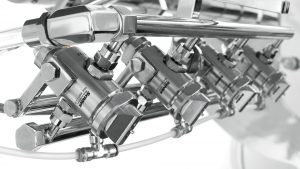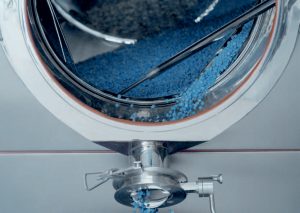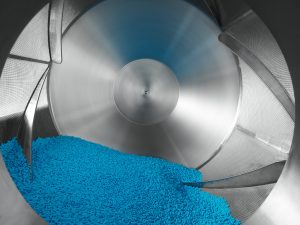
Coating optimization: equipment features to prevent defects.
Caterina Funaro, Process R&D Laboratory Manager at IMA Active Massimo Malavolti, Product Manager for coating equipment at IMA Active |
1. Introduction
The process of coating pharmaceuticals must be carefully controlled to obtain a high-quality end product. This article highlights some equipment features can help you reach that goal.
The first consideration before coating begins is core shape. A flat profile, for example, is a poor choice because it will allow many of the tablets to stick together, a defect called twinning. The next consideration is the coating itself, which must comprise the appropriate ingredients at the specified percentages. Ideally, the coating optimizes wettability and elasticity while delivering solids at the maximum rate without having an impact on viscosity.

Producing high-quality coated tablets also requires identifying the optimal process parameters, which must be in harmony and kept under control. That means combining efficient spray technology with the appropriate mixing baffles and a high-performance drying system. Also critical is a user-friendly control system to manage the process parameters, along with proper maintenance and calibration. Doing so ensures not only coating quality, but minimizes coating losses.
Below are some brief examples of how customizing a coating system’s hardware and software can help you obtain a high-quality result.
2. Foam

Anyone with coating experience knows that the presence of foam in the coating suspension can lead to problems with the final product. Most of today’s coating systems prevent foam by combining the coating powder and liquid usually water using a method that minimizes air entrainment.
Nevertheless, as you near the end of a batch run, it’s possible that the agitator in the coating tank will breach the surface, entrain air, and generate foam. To avoid that, place a level sensor in the tank and connect it to a switch that shuts off the agitator automatically when the suspension is no longer in contact with the sensor.
3. Gun Position
The improper orientation of the spray guns and/or the distance between them and tablet bed can have a big impact on results, including overly wet tablets and tablets with surface defects.
In many cases, operators must monitor the process and adjust the guns manually. If that’s how you operate, consider using a system that adjusts the guns automatically, such as the one our company offers. It uses a laser to detect the orientation of the guns and the gun-to-bed distance throughout the process and adjusts them as needed to keep prevent defects.
4. Number of guns

How many guns you use depends primarily on batch size. But what if the size varies over the course of the batch run.
In one such case a powder layering process the batch grew from 30 to 240 kilograms over a 7-hour run, an eightfold increase. The process was a continuous sequence of spraying a binder onto neutral spheres and then applying a powder API.
Because the batch size would grow over time, the manufacturer opted for a system that automatically varied the number of guns used between 2 and 4 in this case in tandem with the length of the screw feeder that conveyed powder to the process. This ensured the liquid binder and API powder were properly distributed over the full 7 hours without operator intervention. The resulting pellets were uniform in size, smoothness, and shape, and free of defects.
5. Sampling
It’s important to sample tablets from time to time to see whether the operation is under control and the tablets are free of defects. If you operate a contained system, consider specifying equipment that allows you to take samples without breaking containment.
One approach uses a telescopic sampling thief that you guide from outside the pan into the tablet bed, where it gently captures the samples using suction. Once extracted, the tablets are released with a small burst of compressed air. The operation has no impact on the tablets.
6. Loading and discharging

For tablets that break or are easily damaged, adjust how you load and discharge them to and from the coating pan. When loading, for example, position the pan so that the flow of uncoated tablets gently reaches the unloading blade. This prevents the tablets from falling to the bottom of the coater too fast, which could damage them.
7. Other factors

These are just a few examples of how modifying the equipment and/or adjusting it will help prevent coating defects, such as orange peel, twinning, sticking, nonuniform coating or color, and tablet damage. Just keep in mind that many factors can contribute to defects, including the cores, coating, coating recipe, equipment setup, and human error. Because all these factors must be identified, accounted for, and controlled, spend the time to fully assess the equipment and controls of the coating equipment you’re using or considering using.
Ask the equipment suppliers how easily and effectively they can customize the hardware and software to meet your process needs, prevent problems, and allow you to manage the coating process.
